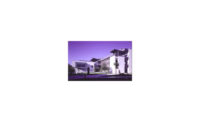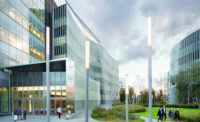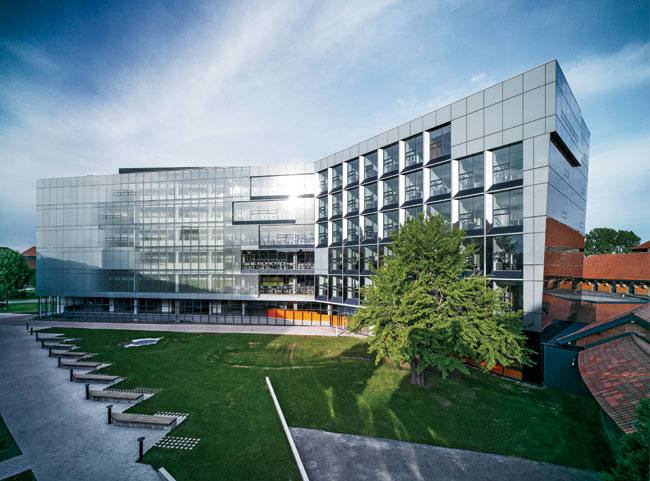Anne-Marie Edward Science Building at John Abbott College
Scientific Bent: A crystalline building for a small college in rural Quebec engages nature in a dialogue about design, learning, and context.






















Architects & Firms
Quebec Province
A century-old gingko tree was the catalyst for the L-shaped design of the Anne-Marie Edward Science Building at John Abbott College outside of Montreal. The six-story structure, designed by Saucier + Perrotte Architectes, bends like an elbow around the gingko, creating a leafy courtyard outside and, inside, neatly dividing laboratories from classrooms and teacher offices. Gilles Saucier, the lead design architect for the job, studied biology before switching to architecture. Celebrating, protecting, and reflecting the tree as a life force defined his approach to this project.
Initially, the college administrators asked Saucier + Perrotte to spread a three-story building over a lightly wooded landscape and connect it seamlessly to Macdonald College (1907), an agriculture training institute next door that is characterized by red-brick buildings with mansard roofs and copper-clad cupolas. For Saucier, it was unthinkable to chop down the site's trees to construct a building dedicated to teaching biology and chemistry. So he convinced the client to save the old gingko, as well as nearby cedar trees. During construction, special care was taken to protect the tree's roots. Today, the gingko is alive and well. 'Nature is more important than architecture,' said Saucier at the building's opening in the fall of 2012 when he was joined on stage by Canadian environmentalist David Suzuki. 'Erasing the memory [of the trees] would have been the worst symbol for a science building.'
The first work of contemporary architecture at the bucolic campus, the 112,000-square-foot building acknowledges its historic neighbors with Cor-ten steel cladding on its north facade that refers to the color of their bricks, though with a different surface texture. Combined with the flex of the building plan and its embrace of the gingko tree, the modern intervention strengthens rather than upsets the aesthetic of the campus. It also responds to the campus plan, orienting its entry to the southwest, where visitors come from the school's central oval. Saucier accommodated an existing curved passageway roofed with terra-cotta tiles by attaching his building to it while adding a metal entry portal in front of it.
As in many of the Montreal-based firm's educational buildings, this one uses various fritted patterns on glass, ranging from opaque (defining the zone for science labs) to translucent (for learning spaces) to transparent (for teachers' offices). Each of the three glazed facades employs mostly a single color of glass'opalescent white, light gray, or dark gray'creating a subtle play of hue and light on the surfaces. The building's many angles and various glass surfaces reflect nature and nearby structures in a complex, almost cinematic manner.
Inside, Saucier envisioned the central stair as an abstract tree'a jagged, kinetic form and a powerful symbol of design in nature. His firm's buildings often feature sculptural, Donald Judd'like stairs, such as those at the Communication, Culture and Technology Building at the University of Toronto at Mississauga and the University of British Columbia Faculty of Pharmaceutical Sciences (record, May 2013, page 98). Most of Saucier + Perrotte's buildings are known for their restrained palettes. But at John Abbott, the firm used a saturated ochre on the stair balusters and landings as a powerful accent. 'I hate gratuitous color,' says Saucier. 'For this project, I wanted to choose a color that would create a moment and add some warmth.'
Following discussions with the client, the architects pushed the few classrooms to the inside of each floor and placed communal seating areas along the perimeter to exploit the daylight. On a recent autumn day, sunlight poured in from glazing above the central atrium and on two sides, turning the main stair into a critical social space filled with students going up and down. The elevator was rarely used.
Designed to achieve a LEED Gold rating, the building captures heat and cool air from geothermal wells located across from the main entrance. It distributes this air through radiant floors at all levels in the atrium and through radiant ceilings in the office areas. The atrium also operates as a chimney, capturing heat for recycling throughout the building. Operable windows on the southwest and west elevations, and in the atrium skylight open automatically in warm weather to provide natural ventilation.
Gilles Saucier's architecture often pinwheels around iconic elements like the century-old tree or free-floating stairs. Though he confronted a more modest construction budget at the Anne-Marie Edward Science Building than he had for some other university projects in Canada, he was able to orchestrate a sequence of spatial experiences with similar impact. He pushed spaces together, then pulled them apart. He carved out big volumes, then dropped ceilings to create more intimate areas. He scattered tubes of light in the main lobby ceiling, then washed the atrium in daylight. Throughout the building, he used a series of visual magnets to draw the visitor forward, which are all the more powerful for being set within a stripped-down palette of concrete columns, white gypsum walls, and gray-tinted glass.
Just as important is the care with which he sited the building, its form bending not just around the ancient gingko but toward the campus's central void and views of nearby Lac St.-Louis and the town of Sainte Anne-de-Bellevue.
PeopleClient: John Abbott College
Architect:
Personnel in architect's firm who should receive special credit: Interior designer: SAUCIER + PERROTTE ARCHITECTES
Engineers: Mechanical / Electrical: PAGEAU MOREL
Consultant(s): LEED Consultant: MARTIN ROY ET ASSOCIÉS Signage design: EPIKA DESIGN General contractor: EBC INC. Photographer(s): MARC CRAMER, OLIVIER BLOUIN, SAUCIER + PERROTTE ARCHITECTES Construction cost: $30.5 million Size: 112,000 square feet Completion date: September 2012 |
Products
Structural system
Exterior cladding Metal/glass curtain wall: Gamma Murs et Fenêtres International Inc. Precast concrete: Fibre C from Rieder
Moisture barrier:
Roofing
Glazing Skylights: Gamma Murs et Fenêtres International Inc.
Doors Metal doors: Les Métaux Tremblay Inc. Garage door: JPR Doors Inc.
Hardware Closers: LCN Exit devices: Von Duprin
Interior finishes Suspension grid: CGC
Cabinetwork and custom woodwork:
Paints and stains: Floor and wall tile: Daltile (Washrooms) Resilient flooring: American Biltrite Marathon Oasis Carpet: Bentley Special interior finishes unique to this project: Acoustical wall panels: Solution Acoustic Inc.
Lighting Exterior: Cooper Lighting; FC Lighting
Conveyance |

















